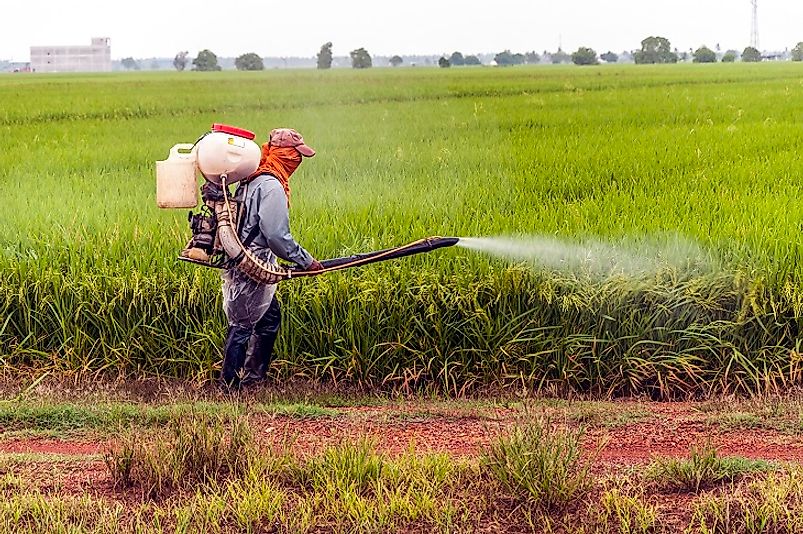Top Pesticide Using Countries

Pesticides are chemical applications commonly used in agriculture. These chemicals serve to destroy such unwanted agents as fungi, weeds, and insects that might otherwise destroy crops or reduce their output. Other industries utilize pesticides as well, to clear roadways of weeds and shrubs, to kill invasive plants, or to control algae growth in bodies of water. Worldwide, 40% of pesticide use is contributed to herbicides, 17% to insecticides, and 10% to fungicides. By using pesticides to ensure maximum crop yield, farmers are able to save money. Some estimates suggest there is a 4-time return on pesticide investments. The negative consequences of pesticide use, however, are many. Application of these chemicals results in environmental degradation, particularly water pollution, and reduced human health, ranging from nerve damage to cancers. This article takes a look at the top consumers of pesticides worldwide.
Top Pesticide Consuming Countries
China
The number one consumer of pesticides is China, where 3,981,548,455 pounds are applied every year. China was one of the first nations to begin using pesticides, copying US practices, and relies on its application for rice crops in particular. Experts suggest that its current use surpasses safe levels and is contributing to environmental pollution and human health problems. The country practices year-round planting and harvesting which has increased pesticide use which has led to soil contamination. The contaminated soil must be treated with increased fertilizers which creates a never ending cycle of agricultural additives. Excessive use of pesticides here leads to runoff into waterways. When lakes or rivers have high levels of pesticides, excessive numbers of plants are able to take over. These plants consume the majority of oxygen available thereby killing off the fish life.
United States
The United States is the next largest consumer of pesticides, applying 850,984,332 pounds annually. Pesticides are so common in this country that even household apply them to lawns and municipalities use them for parks. One study found that every waterway is contaminated with some form of the chemical and approximately 90% of wells sourced by groundwater contain pesticides as well. Pesticide residues on food lead to between 4,000 and 20,000 new cases of cancer every year. The contamination results in anywhere from 6 million to 14 million fish deaths and 67 million bird deaths. Other animal life, especially amphibians, have suffered birth deformities due to nerve damage which also results in population declines.
Other top pesticide consuming countries can be found listed below. Of note when examining the table is the land area of a country. Japan, for example, is found on this list, yet has one of the smallest land areas, meaning its contamination levels are significantly more concentrated. Wherever pesticides are used, however, they can have the same detrimental effects.
Reducing Pesticide Use
While many researchers have suggested that pesticide use is logical when the costs are weighed against the benefits, others suggest that such a rationale simply is not well founded, particularly when damage to the environment and human health is considered. Many countries have begun a movement toward decreasing pesticide use. One way they are doing this is by applying pesticide only when the risk of pests is highest rather than year-round. Another method to avoid overuse is by practicing crop rotation rather than monoculture crop planting which drains resources and soil nutrients.
Organic Farming
Organic farming is another alternative to high pesticide use. In this type of agriculture, farmers rely on natural sources for fertilizers, such as bone meal, manure, and compost, and practice biological pest control. Biological pest control involves releasing predatory insects into gardens so that they eat the pests that might otherwise destroy the crops. This is done by importing the predator species that kill pests, increasing their current populations, or conserving their current populations. The global demand for organically produced food has been growing in recent years.
Top Pesticide Consuming Countries Of The World
| Rank | Country | Annual Pesticide Consumption (millions of kilograms) |
|---|---|---|
| 1 | China | 1,806 |
| 2 | United States | 386 |
| 3 | Argentina | 265 |
| 4 | Thailand | 87 |
| 5 | Brazil | 76 |
| 6 | Italy | 63 |
| 7 | France | 62 |
| 8 | Canada | 54 |
| 9 | Japan | 52 |
| 10 | India | 40 |







